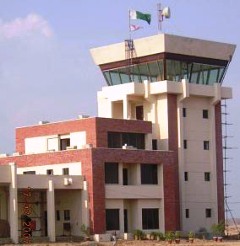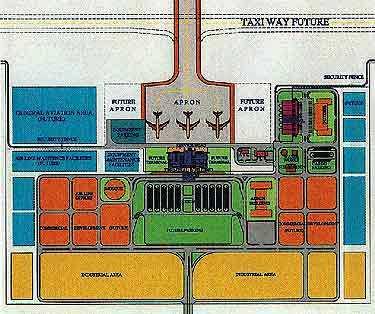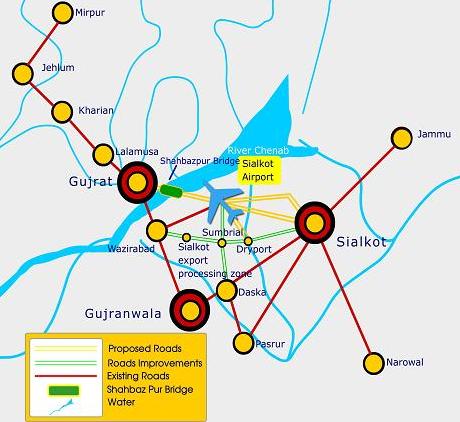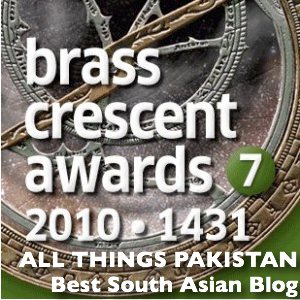 A small yet significant news caught my attention the other day. On November 30, 2007, Sialkot International Airport got its inaugural commercial flight. Pakistan thus adds one more feather in its infrastructure development. The IATA designation of this airport is SKT. It is now the 45th public airport/air strip in Pakistan. There was an inaugural Boeing 737, PIA flight from Karachi the same day, which landed at Sialkot International Airport with 118 passengers. Currently the only flights available to and from Sialkot are from Karachi but very soon Sialkot will get direct overseas flights.
A small yet significant news caught my attention the other day. On November 30, 2007, Sialkot International Airport got its inaugural commercial flight. Pakistan thus adds one more feather in its infrastructure development. The IATA designation of this airport is SKT. It is now the 45th public airport/air strip in Pakistan. There was an inaugural Boeing 737, PIA flight from Karachi the same day, which landed at Sialkot International Airport with 118 passengers. Currently the only flights available to and from Sialkot are from Karachi but very soon Sialkot will get direct overseas flights.
 Sialkot International Airport has been built by the local business community on a “self-help basis†at a cost of US $33 million. Sialkot is very fortunate in a sense that local business community plays a vital role in its development. To build, own and operate this airport a company was established in 2001. It is called the Sialkot International Airport Limited (SIAL).
Sialkot International Airport has been built by the local business community on a “self-help basis†at a cost of US $33 million. Sialkot is very fortunate in a sense that local business community plays a vital role in its development. To build, own and operate this airport a company was established in 2001. It is called the Sialkot International Airport Limited (SIAL).
SIAL is a company with 223 directors, each of which has invested Rs 5m of capital in the project as the primary investment. Each of the directors was invited to take part in the project because of their previous experience of running sizeable and successful enterprises.
 In order to construct the new airport SIAL contracted NESPAK to develop the master plan and after much deliberation and consultation over two years a fully integrated plan was finalised and approved by the Civil Aviation Authority (CAA).
In order to construct the new airport SIAL contracted NESPAK to develop the master plan and after much deliberation and consultation over two years a fully integrated plan was finalised and approved by the Civil Aviation Authority (CAA).
Sialkot International Airport is located 14 km west of Sialkot and is spread over an area of 1050 acres. It also has the longest commercial runway in Pakistan. The runway length is 3.6 km and width is 45m with 7.5m wide shoulders on either side. Civil Aviation Authority (CAA) has graded this runway as 4E.

![]()
The Link Taxiway is 263-meter long, 23-meter wide with 10.5-meter shoulders. The apron covers an area of 45000 sq meters and the airport can nose-in park four Boeing 747s simultaneously.
The construction of the airport was approved in 2001, the construction work started in January 2003 and on March 26, 2005 the first ever plane landed here.
Following image shows convenient road distances from different cities which are projected to benefit from Sialkot International Airport.
10 km west of the airport flows river Chenab and currently there is a bridge called Shahbazpur Bridge under construction there. Once completed, the bridge will reduce the distance between the cities located at either side of the river. It will provide an easy access to the whole region including Sialkot International Airport, Sambrial Dry Port, Export Processing Zone Sialkot and the industries of Sialkot. It will help the airport to become a gateway for the people of Gujrat, Kharian, Lalamusa, Jhelum and Azad Kashmir. The work on this bridge started in 2005 and is expected to be ready in 2008.
Once the overseas flights start from Sialkot, it will become Pakistan’s 9th International airport. Current International Airports of Pakistan are:
1. Jinnah International Airport Karachi (KHI),
2. Allama Iqbal International Airport Lahore (LHE),
3. Islamabad International Airport (ISB),
4. Peshawar International Airport (PEW),
5. Quetta International Airport (QET),
6. Shaikh Zayed International Airport Rahimyar Khan (RYK),
7. Gwadar International Airport (GWD), and
8. Turbat International Airport (TUK).
References:
1. Sialkot International Airport Limited (SIAL)
2. NESPAK





















































RE: What is Sialkot Kent?
Sialkot Kent will move to pasroor leaving behind nice land for rich people , its ok all rich people of Sialkot are providing jobs to many.They deserve better living.
Yes Sialkot was left behind because of being close to border.Now thanks since we are ok with India and thanks to Z A Bhutto for nukes , there will be no war.Sialkot will boom. wait till Jummu and Sialkot border opens up.
India and Pakistan should open borders like USA and Canada.
Rafay Kashmiri
I meant look wise , people do not have to change ,
Sialkot is lovely.
@ali.m.m.Khan
Sialkot being essential part of Punjab, ancient or modern,
was always one of the major city which’ furnished’ soldiers
to British Indian Army and now Pakistan Army, in 1965
one of the biggest tank battle took place in ‘Chawinda’ in
Sialkot.
Bulhay Shah said, “Ki jana mein kon”
(what do I know, who am I ?)
There is no such term as sufi in Islam, we have fabricated
by calling those whome, we think , are mystic ‘sufis’, since
sufism is defined in various ways but etymologically they
are not correct.( will discuss later) In general aspect these
mystics were, as ‘we’ label them ‘ humanists’ known to the
public through their poetry, in the sub-conti, in Persian
Punjabi, Seraiki and Sindhi with poetic sublime existential
stages, (Hall, muqam) esoteric as wll as exoteric.
Islamic city, yes, first, the Ummayad conquest of Multan without War brought many muslims plus enormous conversions to Islam moved the “Sunami” up North including
Sialkot. Then Kashmiri & Afghani alims and pious personalities were always coming down to these cities, Kashmir known as Boukhara-o-Isfahan-e-Sani, in haydays of Kashmir, people use to come from Samarkand, Boukhara and Iran to study.
Sialkot is indeed a small junction of Sub-conti muslims civilization.
Since there is no jurisprudence in Islam for Sufism, that is
why I expressed the term ‘ deviation’ because, it is often
presented as alternative to Islam, you must have heard
” Islam sufi or sufi Islam” the west has started working
in this perverse direction now, and in Pakistan the media
and a special political group is following and promoting
it. Sialkot is not owned by such and such ethnies or
braderies, unfortunately we have grown such tendencies
of castes and race in Pakistan in order to devide people.
Iqbal (born in Sialkot)
Allama Doctor Sir Mohammed Iqbal was titled as
Hakeem-ul-ummat, he was our Tubib,(Doctor) who knew
very well our illness. He was a Kashmiri descendant from
both parents, his father was a Kashmiri Brahman pandit,
(like my ancestors), converted to Islam and settled in
Sialkot, new hometown for many Kashmiri converts and
immigrants, but the biggest concentration was Amritsar
(nearest big city to the valley) , Lahore and then Sialkot
which linked the main route in Gordaspur up north direct road to Srinagar. Iqbal’s poetry is translated into many
languages, In arabic, his ‘Shikwa & Jawab-e-Shikwa ‘ has
a popularity beyond imagination, similarly, in Germany,
Dr. Annemarie Schimmel translated nearly the whole
Iqbal’s work, she was awarded for that, Iqbal is
undoubtedly Pakistan’s spiritual Father of the Nation, the muslims woke up to the realities because of his message thru poetry, anti-colonialism, anti-Brahmanism, anti-clerics
anti-injustice. You need thousands of pages to write about
Iqbal, can you Imagine Dr.Schimmel spent her 30 years
just get ^the translation done for his work.
I think the FAuji F. already has a presence there/……
Rafay K: I did not quite understand what you mean “what deviation !braderies distinctions etc etc” BUT please tell us more about Hakeem-ul-Ummat
P.M. Alvi: I did not know about Faiz….I think sialkot’s close proximity to the indian border has alot to do with the lack of govt. investment, its always been the first to be bombed -65/71. Although i was born there (the military base) i have only been there twice, but yes it was quite a pleasent place to visit…and the fish sure sounds good…